The first cup moistens my lips and throat.
The second shatters my loneliness.
The third causes the wrongs of life to fade gently from my recollection.
The fourth purifies my soul.
The fifth lifts me to the realms of the unwinking gods.
Chinese Mystic, Tang Dynasty
To get into the famed Pu’er tea-growing mountains, the approach takes you through the Gasa International Airport, located within the Xishuangbanna autonomous prefecture in China’s south-west. Here, the region’s temperate climate, mountainous terrain, and laterite and crimson soil combination have provided an ideal haven for the tea plant, which has grown wildly over millennia and been cultivated for centuries.

I’m here with Polygreen Tea’s director, May Chong, who represents the second generation of a Malaysian tea trading business founded at the onset of the Pu’er tea boom in the early 2000s. Chong herself is a qualified National Senior Tea Ceremony Master, which entails an examination of 1,000 questions on theoretical knowledge as well as a practical course on conducting tea ceremonies. Chong remembers how her father, Chong Kok Chin, had developed an interest in tea on his numerous work trips to China. This interest led him to begin trading tea two decades ago, which he did by the container loads.
The senior Chong would continue his Pu’er fascination, hobnobbing with the movers and shakers of the tea industry back in China and, in the process, become one of the major tea buyers from Southeast Asia. Polygreen’s continued support of the export business of Pu’er from Xishuangbanna enabled the business to build up its large inventory of tea and tea products in their warehouse, stock of which has been ageing quietly and peacefully for the past several decades.

Malaysia’s constant climate and the Klang Valley’s inland humidity help to mature the teas in optimal conditions, before the very same teas are shipped back to China and other tea-loving markets such as Hong Kong and Taiwan, fetching a premium due to its optimally aged conditions. The exponential increase in value is especially true in the case of raw Pu’er tea, which has garnered headlines for eye-watering auction prices, such as the 100-year-old Ziping Fu Yuanchang Pu’er, which was hammered down in 2019 at HKD26.32 million (approximately RM15 million) for about 2.2kg of tea.
Although the Pu’er boom cycles and appreciation have been well known in Greater China for the past two decades, tea culture here in Malaysia has yet to take root in the same way. Hence, it’s why I find myself at the origins of the Pu’er industry, a significant contributor to the tea trade—one that has made China the world’s largest tea market, generating revenue of US$26.4 billion (RM116.8 billion approx.) last year, according to industry market researcher IBISWorld.

Menghai county, famed for its exceptional tea terroir and centuries-old tea trees, is located at the border of Myanmar and Laos, and within the Xishuangbanna prefecture, which forms part of the Yunnan province. The Menghai area is dominated by majestic mountain ranges—including the six famous tea mountains 六大茶山—verdant valleys, and agricultural tracts, as well as rainforests that are still home to Asian elephants. The importance of tea in this area is evident, from giant billboards and monolithic buildings dedicated to the trade to its cuisine in which tea leaves add an especial aroma and flavour.
As the road wends into the mountains, we pull into the Yang Pin Hao tea manufacture, one of the 21 key tea manufacturers in Menghai county and, more recently, given a CNY150 million (RM90.8 million approx.) upgrade of its facilities across over seven acres (300,000 sq ft) of land. This development includes state-of-the-art production floors, storage, laboratories, accommodation for guests, and landscaped gardens with myriad waterfalls. Most impressively, its main hospitality area is a palatial recreation of Han and Tang dynasties, a signature architectural style of one of China’s top-ranked property developers, C&D Real Estate Corporation. 
Inside, one finds the encapsulation of the life’s work of Anxi native Lin Junli, whose plucky move to Menghai in 2004 saw him establish himself in the tea business as a manufacturer and trader. He was initially involved in the tea trade with Tie Guan Yin, a Chinese oolong tea, but realised that this variant of tea carried a short sell-by date. Hence, in 1997, he made the decision to move into Pu’er as it attained even more value with time and “had no expiry date”, which suited him much better. “I initially envisioned a small factory and a business,” Lin says, recounting that he had faced initial challenges as an ‘outsider’ in this county. However, in time, with his desire to prove himself and his perfectionist ways, Lin would earn the trust of both local suppliers and regional buyers.
Today, some 21 years since Lin set foot in Yunnan, the Yang Pin Hao tea manufacture is among the best examples of a modern-day tea manufacture, with its impressive welcome of stone lions, opulent screen wall, tranquil courtyard, tea salons adorned with giant floral arrangements, and beautiful guest rooms equipped with Frederic Malle toiletries, Duravit bathroom furniture, and AI assistance. He also counts some of the largest Chinese beverage makers among his clients, with the country’s largest, Nongfu Spring, purchasing several thousand tonnes of aromatic ripe Pu’er from him for use in their tea products.

The brand name of Yang Pin Hao harks back to one of the most legendary tea makers—Yang Pin San, who founded the brand in 1912, producing many renowned Pu’er cakes up till the interregnum of the second world war and subsequent nationalisation of private enterprise. In 2000, realising that he needed a brand name to anchor his Pu’er business, Lin met with the subsequent generation of Yang Pin San, and negotiated for the purchase and use of their time-honoured trademark. (This also had the extra advantage of helping him bypass the four-year period of registering a new mark.)
Back at the tea salon in Yang Pin Hao, to the lilting music of classical Chinese instruments, the female tea master Xiao Yu serves up Pu’er with a sense of ceremony, balletic motions, and learned patter, thanks to a graduate degree in tea. She serves a crystalline gold-coloured Bing Dao Pu’er, which is light, floral, and sweet—the Queen of Pu’er, as she describes it. A few infusions and pours later, we then take on the King of Pu’er, the Ban Zhang, which is darker, smokier, and uniquely bitter before segueing into a long, sweet finish.
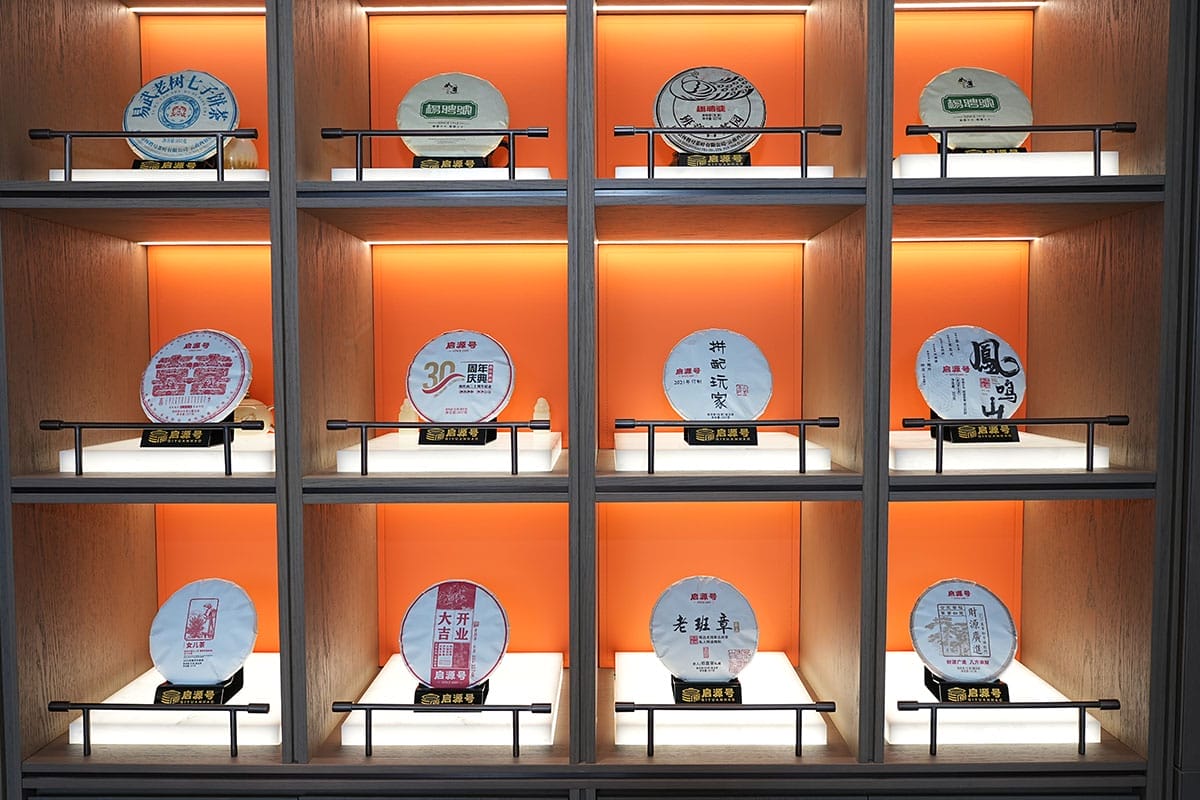
Beyond Ban Zhang, one finds Lao Ban Zhang (which essentially means Old Ban Zhang). The tea harvested from these trees are the Château Lafite of the tea world, a result of a natural scarcity through terroir limitations and the simple fact that you would need a minimum of 300 years to replicate Lao Ban Zhang.
About an hour’s drive from Yang Pin Hao, I find myself in Hekai Ancient Tea Farm, a forest growing at an altitude of more than 1,500m above sea level, comprising centuries-old tea trees. This ancient tea forest was largely unknown to the outside world until 2008, when the rapid flowering of the Chinese economy also benefited local planters, who, in turn, saw the value of their yields rise by several thousand times.
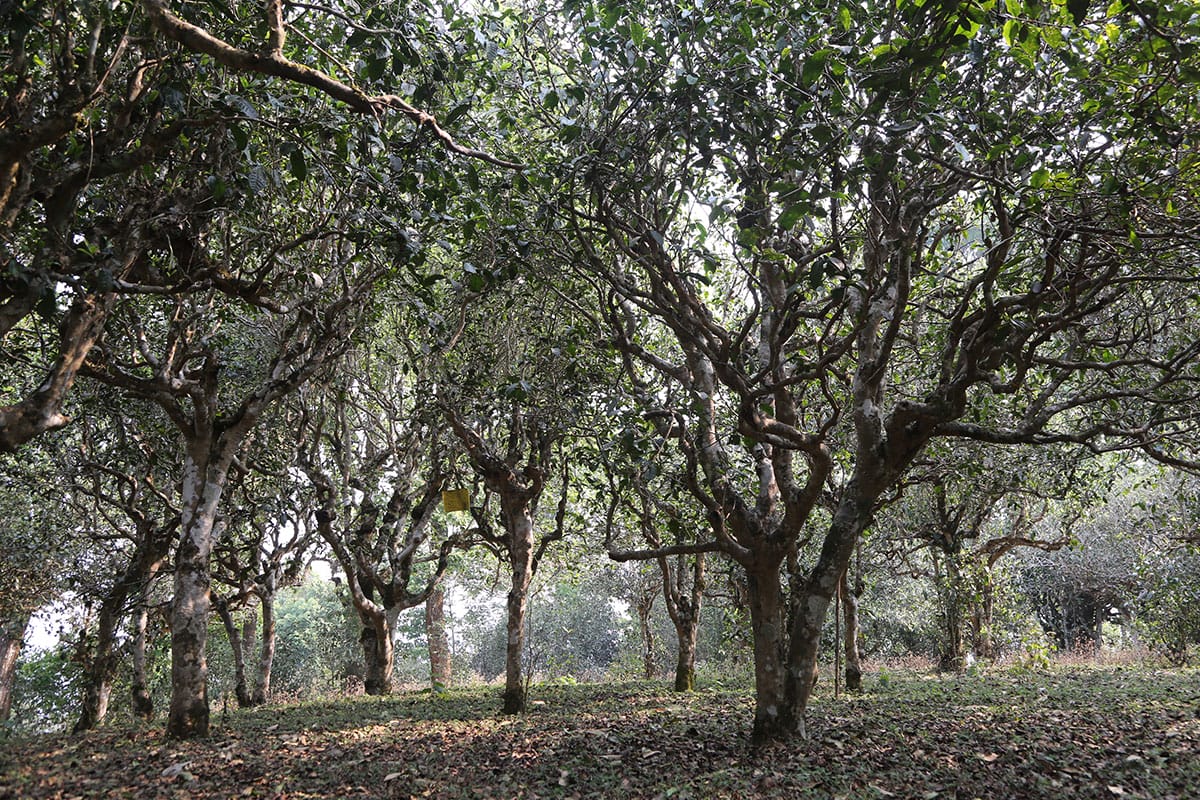
Today, this entire area is a blossoming gold mine of Lao Ban Zhang, tea trees of the camellia sinensis var. assamica species that have flourished in this region of constant climate and well-drained, crimson soil. Unlike the smaller leaf tea bushes that appear as neat terraces in picturesque tea plantations, these tea trees grow up to more than two metres, with a taproot that grows proportionally to its tree height. The importance of this specific terroir is that it forces the tree to work hard to extract nutrition from the earth, synthesising these minerals into nutrient-rich and deeply aromatic buds with remarkable ageing potential. These botanical traits are greatly similar to aged grape vines and terroir lending powerful ageing potential to its resultant wines.
Er Di, a 29-year-old tea planter of the Hani people, is one of the many locals who now work this land. Some while ago, the mountainous tracts with the prized Lao Ban Zhang were carved out into more than 170 subplots for the locals who trace their ancestry to the indigenous mountain tribes of Yunnan. The most prized trees are worked on by specific pickers, who look for the brilliant spring green buds from the tea tree. These buds are carefully segregated into specific bags, with the first pick in springtime of between 300- and 500-year-old trees being the most prized.

Each year, the first springtime pick becomes the busiest period for the planters and tea makers, as this harvest is usually made into the raw or green version of Pu’er, one that represents 20 per cent of all Pu’er in the market, with ripe Pu’er being the rest. Raw Pu’er is also most desired for its ageing qualities, maturing and naturally fermenting through time and interaction with the surrounding conditions to attain remarkable character, aromas and sensations, and reduced astringency.
Back at Lao Ban Zhang village, the effervescent Er Di declares that the harvest for 2025 came a bit late due to the lack of rain, and that her family and their workers were hard at work picking, drying, frying, rubbing, and drying (again), all within a day’s work to ensure the characteristics of the tea are properly locked in to preserve all of its best natural qualities. For every seven kilograms of harvested tea buds, it becomes only two kilos once it is roasted, which also explains the concentration of taste in the compressed Pu’er cakes. At present, each kilogram of newly produced Lao Ban Zhang will fetch RMB15,000 (RM9,000 approx.), and Er Di and her brother will end up producing between 700kg and 800kg of the first spring tea, ranging from the younger trees to the 300-plus-year-old trees by the end of the harvest season.
Due to Yunnan’s subtropical climate of dry and rainy seasons, conventional wisdom dictates three harvests, with a second one in late spring and the third in summer. Then, as the rains begin, the trees get their rest. Similarly, in the remote neighbouring Mengla county, the same occurs for the ancient trees from Yiwu tea trees, which bear an equally prestigious provenance, and are referred to as the Domaine de la Romanée-Conti of Pu’er by one of the luminaries in the Pu’er trade, tea master Guo Zi Jian.
History books reflect how tea has served as an imperial tribute for more than 3,000 years. Pu’er was invented as a fermented brew during the Tang dynasty (608–907) and, in the Qing Dynasty, the ones originating from Yiwu would travel thousands of miles along the old Tea Horse Road to Kunming and then onwards to Beijing for the emperors.
In Xiamen, I meet Guo Zi Jian, the permanent honorary president of the World Culture Association of Tea, who has served two terms as association president (ninth and 10th). Guo also holds the distinction of being a national-level senior tea evaluator, the highest professional qualification for tea professionals. 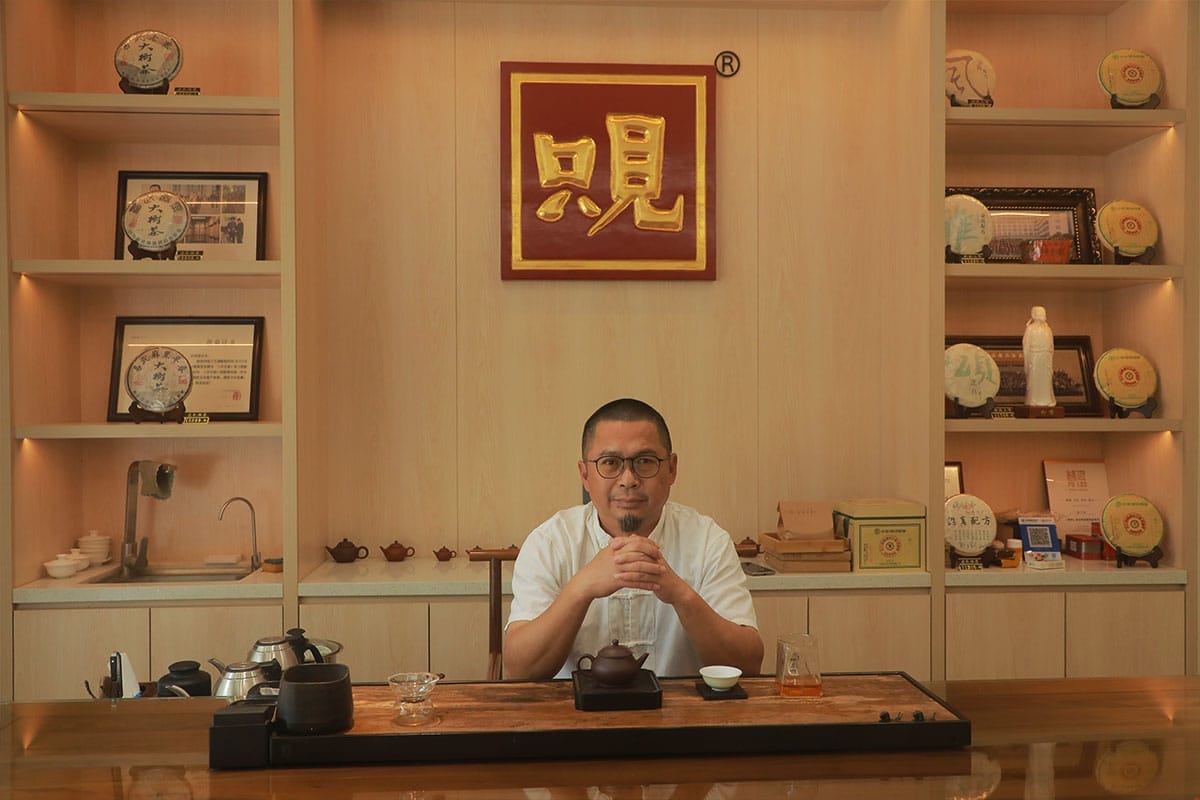
At his tea shop, Zhi Jian, Guo explains in his gravelly voice that Xiamen became a popular confluence for fine tea because the city was very accepting of all kinds of tea, unlike many other regions in China that were specific to only certain types of tea. Furthermore, the non-polluted conditions of his native Anxi province allows for Pu’er to mature beautifully.
In a year, Guo transacts between 300,000 and 400,000 kg of tea and, in his capacity as a tea master, has produced Pu’er vintages that now take pride of place in the Beijing Tea Museum. In the tranquil confines of his tea salon, he recalls how the price of quality Pu’er has risen, on average, nearly 40-fold from 1989 to 2002, as he offers a Zhong Cha-branded Pu’er purchased at RMB800 (RM480 approx.) per 357g compacted tea cake from 20 years ago, which is now worth RMB200,000 (RM120,000 approx.). The reason? Scarcity, as only around 300 cakes were produced then.
“It’s important that people are prepared to recognise trends and opportunities,” Guo says. He himself was first exposed to Pu’er in 1996 and, a couple of years later, journeyed to Yunnan to uncover the origins of this wonderful Pu’er tea that was attaining popularity in newly affluent cities such as Guangzhou and Zhuhai, as well as in overseas markets such as Hong Kong and Malaysia. At the turn of the millennium, Pu’er would surge even more, fuelled by China’s increasing affluence and the correspondingly grand dinners that necessitated a tea which could aid digestion and, at the same time, offer a measure of prestige.
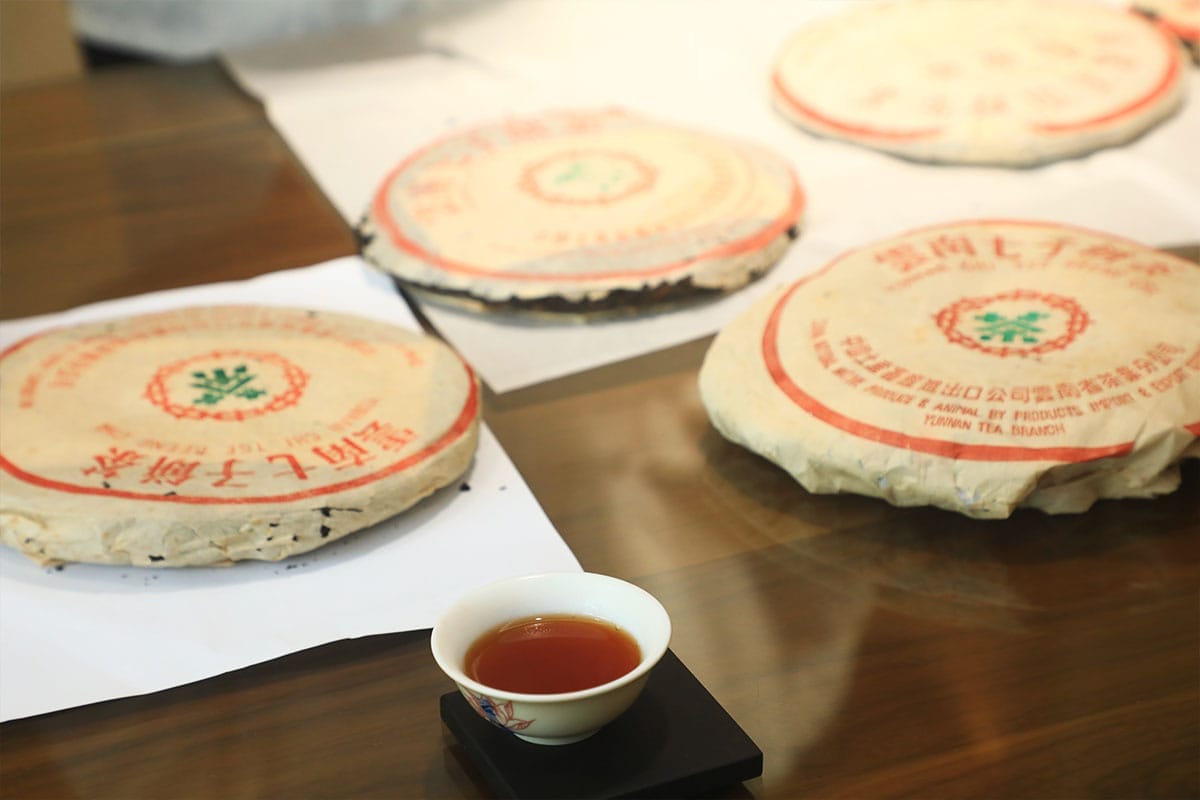
Vintage Pu’er was the one that checked all the boxes, with plenty of studies and empirical evidence to back this up. In published abstracts from the National Library of Medicine, Pu’er has been shown to help with better sleep, combat neurosis, raise alertness, and also help with weight loss and introducing probiotics into the gut. In various other published papers, medical researchers have identified the presence of polyphenols, natural statins, theabrownin and polysaccharides in Pu’er to play a role in improving blood sugar control, decrease risk for cardiovascular disease, and inhibit cancer growth.
According to Guo, the catalyst to this was when senior government officials visited Yunnan in 2004. Upon realising how undervalued the tea sold out of this region was, versus the skyrocketing demand for the same tea in consumer markets, they organised a government forum to lead the development of the tea industry in Yunnan, intended to uplift the lot of tea planters and manufacturers. The resulting growth of the industry, characterised as ‘the bloom of a 100 flowers’ (百花齐放), would eventually result in the initial number of 10 tea manufactures and makers growing to more than 10,000.
Among the forerunners of these tea manufactures is Taetea, the tea industry leader with an annual production of 10,000 tonnes of finished tea. It traces its roots to the Menghai Tea Factory of 1940, set up by a group of 90 tea professionals from all over China. Today, Taetea runs modern production facilities, has more than 2,000 brand franchise stores, and owns two ecological tea gardens in the Bada and Bulang Mountains.

At Qing Yi Tang tea salon in Shenzen, I meet Percy Kwok, Pu’er tea connoisseur and a director of Natural Buy Limited, who also holds a Taetea franchise. He offers a very candid retelling of how he stumbled into Pu’er tea. For some years, he had come to know the ‘godfather of Pu’er tea’ Pak Shui Ching. Polygreen’s Chong details how Pak Shui Qing, together with his seven disciples, were responsible for the success of Pu’er in the key markets of Hong Kong, Taiwan, and China, thanks to their mastery of Pu’er, access to superior quality tea, comprehensive recipes, and network.
Over sips of an exceptional 1930s Pu’er vintage, together with Pak Shui Ching’s sons Daniel and Dennis, I am regaled by recollections of their tastings, including an 1883 Pu’er vintage made during the late Qing dynasty. Here, in their Shenzen tea salon, one can marvel at Pak’s own 8582 tea formulation as well as the first Pu’er cake produced by Taetea post-privatisation. The latter adopted the ‘dayi’ (大益) logo, a seminal moment from 1996 that heralded a milestone in Pu’er’s modern history. For Kwok, his own epiphany with Pu’er came after some years of sipping tea with the senior Pak, when he questioned why he could not appreciate Pu’er in a similar fashion as Pak. To which Pak’s elegant reply was: “Because you haven’t put any money into it.”
The present and future of Pu’er can be found in Xiamen, at the beautifully restored four-storey Wing Yuen Tea House located across the picturesque Zhongshan park, established for nearly a century and bursting with birdsong and life in the city’s downtown heritage area.
Here, I meet with Wing Yuen Tea House’s general manager Michael Wong and his wife, Annie Huang, who is also the company’s head of human resources. Michael represents the second generation of his own family’s tea business, the son of the Wong Man-yuen who arrived in Hong Kong in 1981 from his native Anxi in Fujian with only 6kg of Tieguanyin and not a dollar to his name. However, his unshakeable belief saw him make a hundred-fold return on his initial tea capital, leading him to set up the Wing Yuen tea shop in Hong Kong’s North Point, selling tea wholesale.
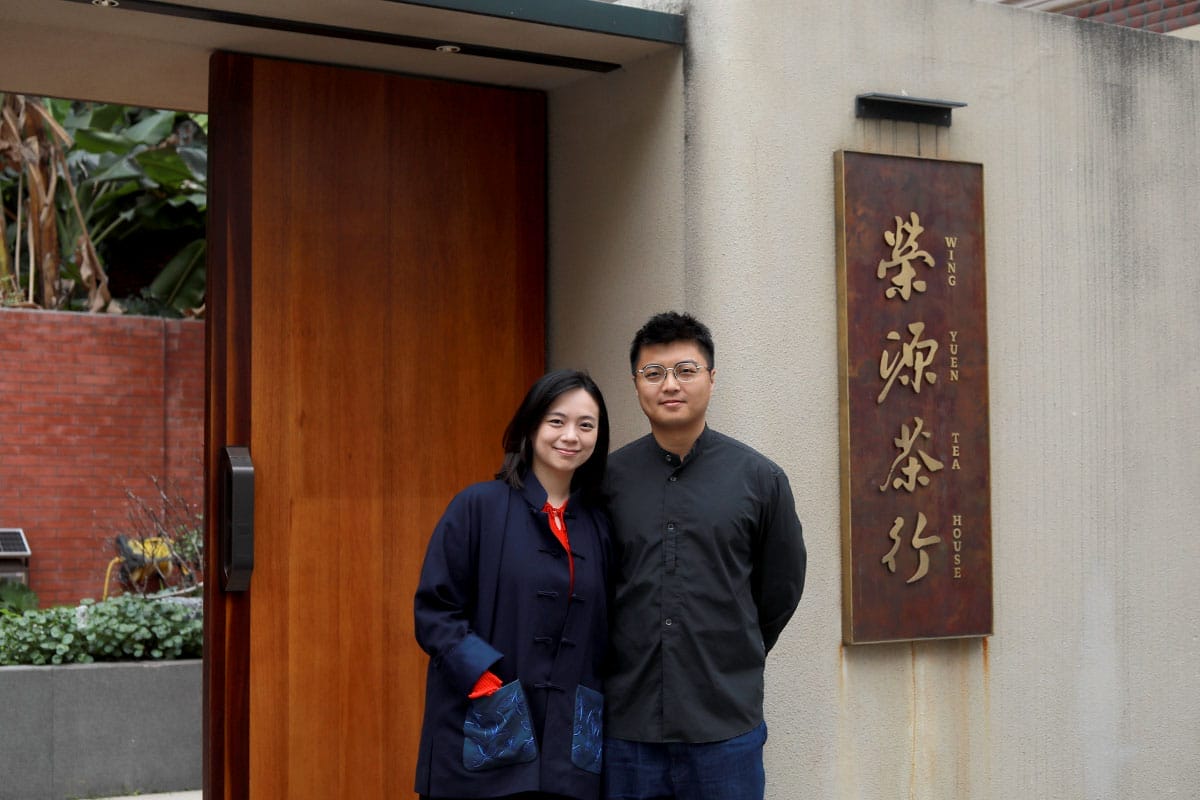
In a decade, Wong Man-yuen’s tenacity would see him selling tea to key tea-drinking territories across Asia and even Europe. He would also, in 1987, sojourn to Yunnan to work with the planters on picking the best tea buds, which enabled him to develop his own Pu’er tea. All this would lead him to establish and be elected the first president of the World Culture Association of Tea.
The Wing Yuen, which is now both a tea wholesaler and retailer, has a deep inventory of tea, with Michael putting estimates at nearly 18,000 pieces of Pu’er cakes of varying vintages. Among the most famous of his father’s Pu’er formulations is the 8892. However, with the changing of times, Michael himself understands the value in innovation and, having spent his lifetime in the tea business, he is now releasing new crossover tea blends that are infused with essences of local markets, such as a red bean-accented tea reminiscent of the Hokkien ‘ang koo kueh’ and even one called ‘Little Nyonya’. He has also collaborated with other Chinese brands to produce gift sets of Wing Yuen Pu’er sachets packaged with local spirits such as gin and whisky.
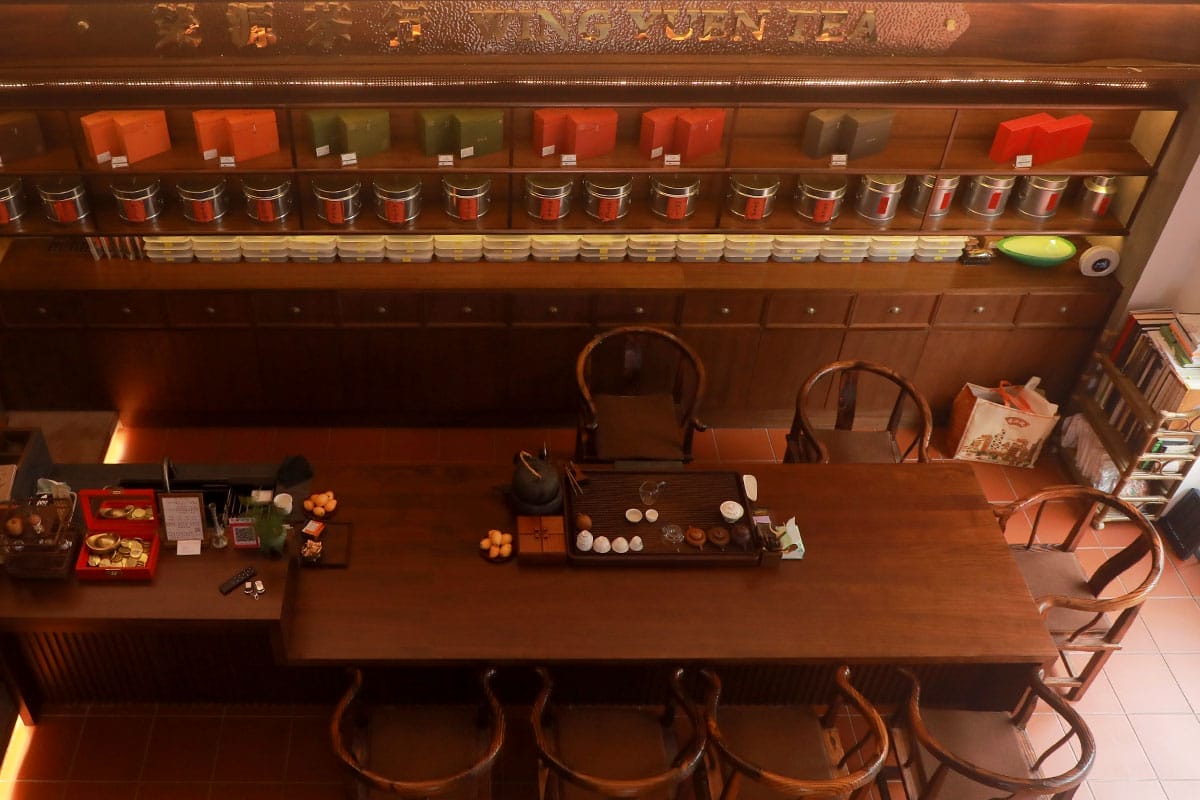
“My dad’s advice has always been to keep the tradition and, at the same time, become more creative,” Michael says. “The biggest lesson, however, is that trust is very important, and selling one wrong tea will undo a lot of good reputation.” For Michael, studying the past has helped him understand the importance of gleaning lessons from history, and knowing how tea connects to the mind, body, and soul.
As Michael pours the second cup of steaming Pu’er, usually twice as strong as the first pour, he talks about how enjoyment of Pu’er can only occur with knowledge. From bark and moss, to forest honey flavour notes, the best vintage Pu’er has been known to be transformative. Michael himself describes a good Pu’er as having a lingering finish, traversing deep into the gut, and suffusing the body with heat. “It’s not just what you taste in your mouth,” he says and, after another sip, continues, “it’s what you feel in your body.”
THE ESSENTIAL AGES
Guo Zi Jian, permanent honorary president of the World Culture Association of Tea, two-term president and also national senior tea evaluator, describes the maturation of raw Pu’er, where years add on complexity and value to the experience, and equates the evolution of vintage Pu’er to the life of a human being.
New Pu’er: Is like a new-born infant. Raw and green.
One to five years: Like a child in kindergarten stages, under the care of nature.
Six to 12 years: Like going to the primary school stages, still looking for definition. The fermentation process is slowly progressing, and the tea starts awakening, so you still don’t see so much performance in terms of taste and aroma.
12 – 20 years: The secondary stage where growth is rapid—the fermentation accelerates as the microorganisms get to work. Unlike wine, in which the yeast is already present, with Pu’er, nature has to play a hand in introducing the right catalyst, which are the microbes that improve the taste of vintage Pu’er.
20 – 25 years: This stage is akin to the starting of adulthood. It tastes very fresh but still maintains its raw edge. The quality of Pu’er at this point can still be somewhat volatile.
25 – 30 years: Like a university graduate going out to work. The consistency of Pu’er at this age is stable and gradually improving. Pu’er is usually sold at this level of ageing as it’s already at a very acceptable level for those who are used to drinking premium vintage Pu’er. The caveats, of course, are that the tea must come from a good origin and must be properly stored.
30+ years: This is the point where Pu’er attains and showcases its beautiful characteristics, delivering an impeccable taste and aroma.
40 – 50 years: It finally evolves to its plenitude—revealing the fullness of the Pu’er’s characteristics, drawing on the depth of Pu’er’s ageing potential and the richness of its very core.
50 – 60 years: For the rarest Pu’er that possesses an ability to age beyond this point, the tea continues to demonstrate the characteristics as described between 40 and 50 years of age, but the maturation and ageing decelerate. Pricewise, it continues to appreciate because Pu’er at this age is much scarcer—and every cup you drink means one less in the world.
Photography by 阿清摄影 & 小秦










